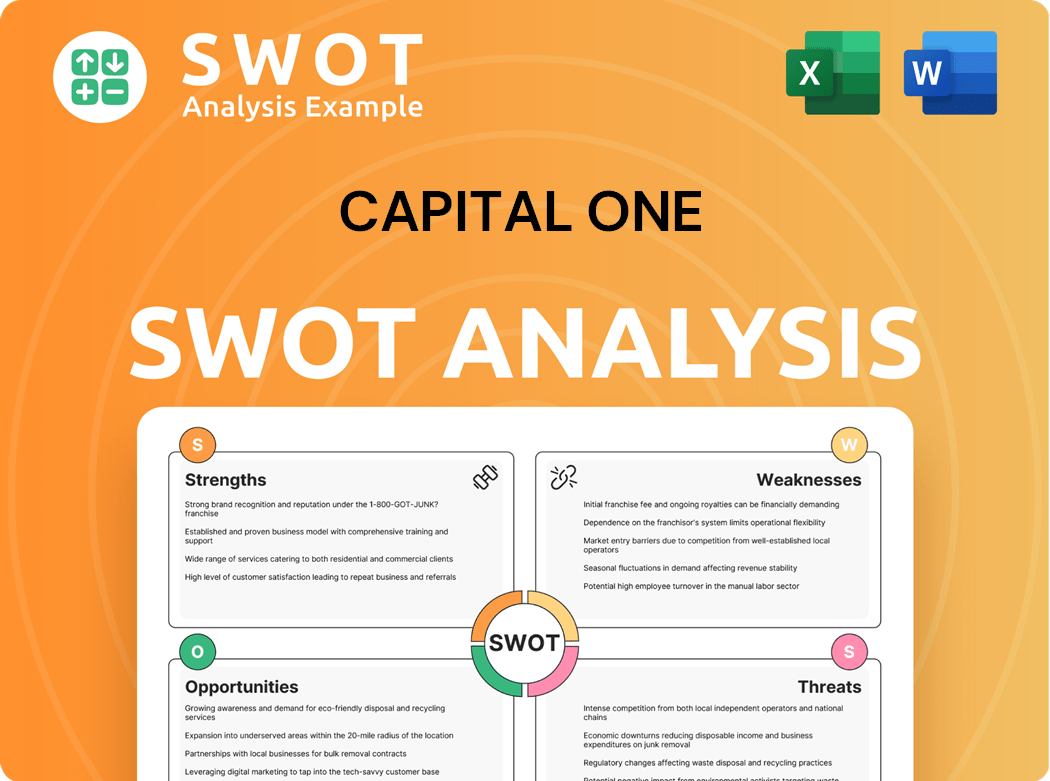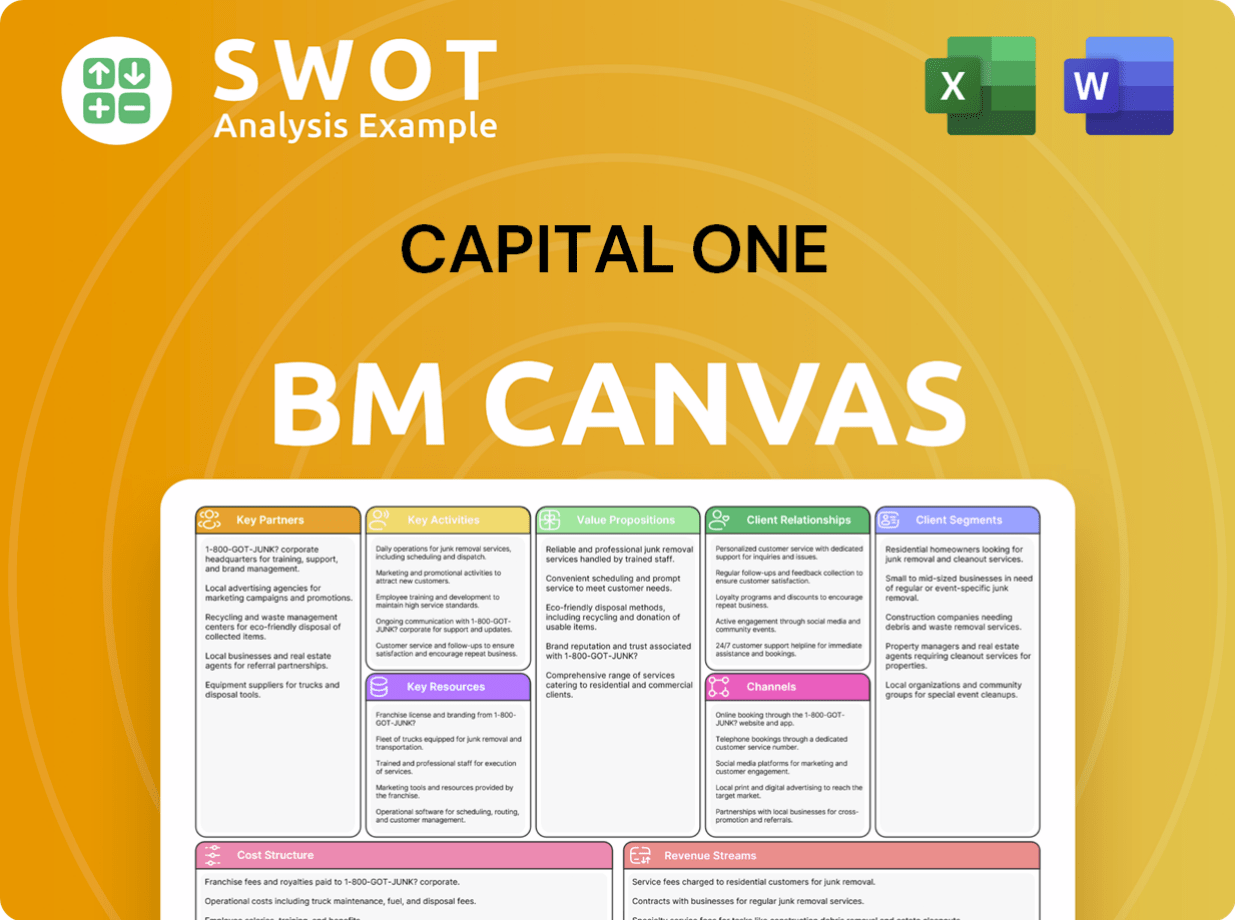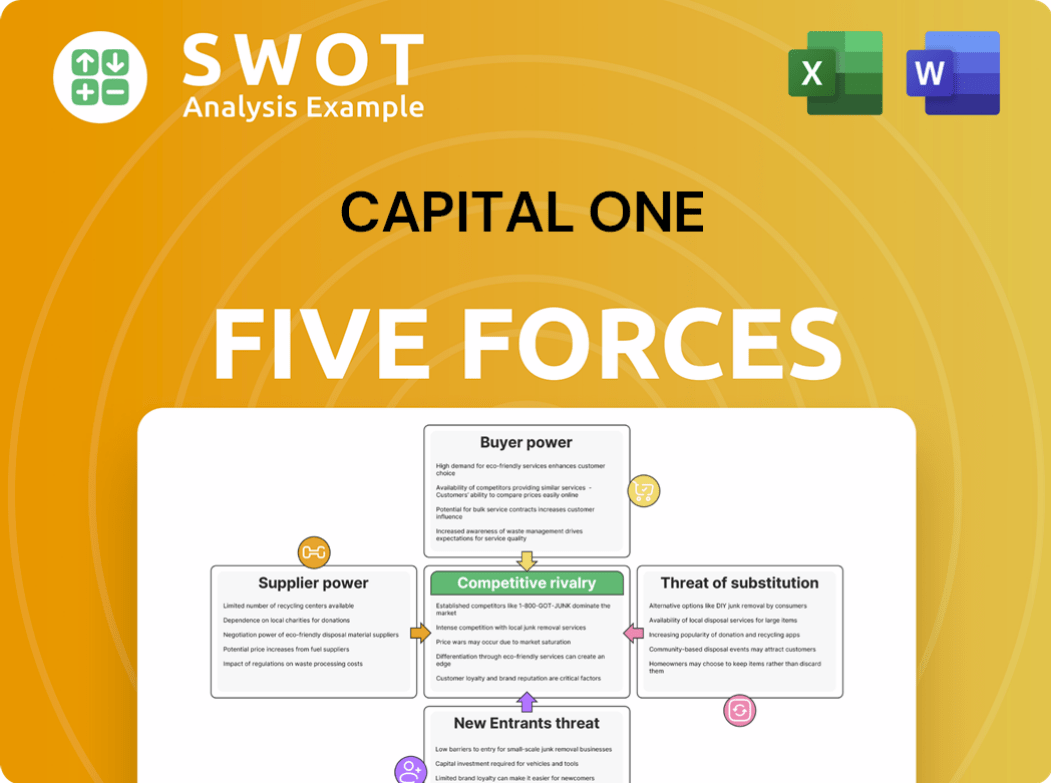Capital One Bundle
How Will Capital One Reshape the Financial Services Arena?
The financial world is abuzz with Capital One's strategic moves, particularly its planned acquisition of Discover Financial Services. This monumental shift, valued at billions, is poised to redraw the lines of competition. This is a pivotal moment to understand the evolving Capital One SWOT Analysis and its implications for the entire industry.

Capital One's journey from a credit card disruptor to a financial services giant is a testament to its data-driven approach. Understanding the Capital One competition and its position in the Capital One market analysis is now more critical than ever. This analysis will delve into the Capital One competitive landscape, exploring its Capital One rivals and the dynamic shifts within the Capital One industry, especially considering the recent acquisition and its impact on the broader Capital One financial services sector.
Where Does Capital One’ Stand in the Current Market?
In the competitive landscape of the financial services industry, Capital One holds a significant position, particularly in the credit card and auto loan sectors. A thorough Capital One market analysis reveals its strong presence in the U.S. market, where it competes with major players. The company's strategic focus on digital transformation and a diverse product range has allowed it to maintain a competitive edge.
Capital One's core operations revolve around consumer and small business lending, with a growing presence in commercial banking. As of early 2024, its credit card business is a major revenue driver. The company's ability to adapt to changing market dynamics and customer preferences is crucial for its continued success. This adaptability is evident in its investments in digital platforms and its expansion of product offerings.
The company's value proposition centers on providing a range of financial products and services, including credit cards, auto loans, and banking solutions. Capital One aims to offer competitive terms and innovative features to attract and retain customers. Its focus on customer experience and technological advancements further enhances its value proposition.
Capital One is a leading credit card issuer in the U.S. market. As of early 2024, it holds the third-largest position by purchase volume. This places it behind only JPMorgan Chase and American Express. The company's credit card loan portfolio reached $147.7 billion at the end of 2023.
Capital One is also a significant player in the auto lending sector. The company holds a substantial market share in this segment. Its ability to provide competitive auto loan products contributes to its overall market position. This is an important part of the Capital One competitive landscape.
Capital One has invested heavily in digital transformation to enhance its online and mobile banking platforms. This focus on technology allows the company to cater to evolving customer preferences. These investments are crucial for maintaining a competitive edge in the Capital One industry.
Capital One's financial health remains robust, with total assets reaching $476.1 billion as of December 31, 2023. This makes it the ninth-largest bank in the U.S. by assets. The company's strong financial position supports its ability to compete effectively.
Capital One has strategically shifted its positioning over time, broadening its product offerings. Initially focused on subprime credit cards, the company now offers a more diverse range of products across the credit spectrum, including premium offerings. This diversification helps Capital One to attract a wider customer base and mitigate risks.
- Expansion beyond subprime credit cards to include premium offerings.
- Focus on digital transformation to enhance customer experience.
- Growing presence in commercial banking to diversify revenue streams.
- Strong financial performance, with $476.1 billion in total assets as of December 31, 2023.
For a deeper understanding of Capital One's business model, consider exploring the Revenue Streams & Business Model of Capital One.
Capital One SWOT Analysis
- Complete SWOT Breakdown
- Fully Customizable
- Editable in Excel & Word
- Professional Formatting
- Investor-Ready Format

Who Are the Main Competitors Challenging Capital One?
Understanding the Capital One competition is crucial for a comprehensive Capital One market analysis. The Capital One competitive landscape is shaped by a diverse group of financial institutions and fintech companies. This analysis provides insights into the key players and their strategies within the financial services sector.
Capital One rivals compete across various business lines, including credit cards, auto loans, and banking services. The competitive environment is dynamic, with traditional banks, fintech startups, and specialized lenders vying for market share. This overview examines the major competitors and their impact on Capital One's business.
In the credit card sector, Capital One faces strong competition from established players and emerging fintech companies. Key competitors include JPMorgan Chase, American Express, Citigroup, Bank of America, and Discover Financial Services. These companies compete through product offerings, rewards programs, and customer service.
JPMorgan Chase is a major competitor, offering a wide range of financial products and services. It competes with Capital One in the credit card market, auto loans, and banking. JPMorgan Chase's vast customer base and diverse offerings make it a formidable rival.
American Express focuses on affluent customers and small businesses, with a strong brand and rewards programs. It competes with Capital One in the premium credit card segment. American Express leverages its brand to attract and retain customers.
Citigroup and Bank of America offer a wide array of credit card products, often integrated with their broader banking services. These banks compete with Capital One across various credit card categories. They leverage their extensive banking networks to attract customers.
Discover Financial Services competes in the credit card market with a focus on rewards and customer service. The proposed merger with Capital One would change the competitive dynamics. The merger aims to consolidate market share and enhance competitive positioning.
In the auto lending market, Capital One competes with captive finance companies like Toyota Financial Services and Ford Credit, as well as other large banks and credit unions. These competitors offer auto loans to consumers. Competition is high due to the size of the auto loan market.
For its banking and savings products, Capital One competes with traditional brick-and-mortar banks such as Wells Fargo and PNC. It also faces competition from a growing number of online-only banks and fintech platforms. These competitors offer competitive interest rates and user-friendly digital experiences.
Emerging fintech players, particularly those specializing in buy now, pay later (BNPL) services or mobile payment solutions, also pose an indirect challenge by altering consumer spending habits and payment preferences. These companies are changing the Capital One industry. Understanding these competitive dynamics is crucial for assessing Capital One's future outlook.
Several factors influence the competitive landscape. These include market share, customer base, and product offerings. Understanding these elements is important for assessing Capital One's position in the financial market.
- Market Share: JPMorgan Chase and Bank of America hold significant market share in the credit card sector.
- Customer Base: American Express focuses on affluent customers, while Capital One serves a diverse customer base.
- Product Offerings: Competitors offer a range of credit cards, auto loans, and banking products.
- Digital Innovation: Online-only banks and fintech platforms compete through digital experiences.
- Mergers and Acquisitions: The proposed merger with Discover Financial Services will change the competitive landscape.
Capital One PESTLE Analysis
- Covers All 6 PESTLE Categories
- No Research Needed – Save Hours of Work
- Built by Experts, Trusted by Consultants
- Instant Download, Ready to Use
- 100% Editable, Fully Customizable

What Gives Capital One a Competitive Edge Over Its Rivals?
Capital One's competitive advantages are rooted in its strategic use of data and analytics, strong brand recognition, and commitment to digital innovation. The company has consistently leveraged data-driven insights to refine its customer targeting, risk assessment, and product offerings, setting it apart in the financial services sector. This approach has enabled Capital One to efficiently acquire customers and manage risk effectively.
The company's brand strength, especially in the credit card market, is another key advantage. Capital One has cultivated a reputation for a diverse product portfolio and a customer-centric approach. Furthermore, its substantial investments in technology and digital platforms have provided a significant edge, enhancing customer experience and operational efficiency. Capital One's ongoing digital transformation and focus on customer experience are critical to its sustained competitiveness.
Capital One's competitive landscape is dynamic, with its rivals constantly evolving. A Brief History of Capital One reveals the company's evolution and its strategic responses to market changes. Capital One's ability to adapt and innovate has been crucial in maintaining its competitive edge in the financial services industry.
Capital One's use of data analytics for customer acquisition and risk management is a core competitive advantage. This allows for precise targeting of customer segments and customized product offerings. The company's data-driven approach enables it to make informed decisions and adapt to market changes quickly.
Capital One has built a strong brand identity, particularly in the credit card market. Its diverse product portfolio and customer-centric approach have contributed to this recognition. This strong brand helps attract and retain customers, supporting its competitive position in the financial services industry.
Capital One's investments in technology and digital platforms provide a distinct edge. Its online and mobile banking applications, along with features like Eno, enhance the customer experience. These technological capabilities contribute to operational efficiencies and rapid product development.
The proposed acquisition of Discover is expected to enhance Capital One's competitive advantages. This move could expand its payment network capabilities and increase its scale. The acquisition may lead to greater economies of scale and enhanced negotiating power in the market.
Capital One's competitive advantages are multifaceted, combining data analytics, brand strength, and digital innovation. The company's strategic focus on these areas has allowed it to maintain a strong position in the financial market. These factors contribute to Capital One's ability to compete effectively.
- Data and Analytics: Utilizing sophisticated statistical analysis to assess credit risk and target customer segments.
- Brand Recognition: Building a strong brand identity, especially in the credit card market, through a diverse product portfolio and customer-centric approach.
- Digital Innovation: Investing in technology and digital platforms to enhance customer experience and operational efficiency.
- Strategic Acquisitions: The potential acquisition of Discover could further bolster its competitive position.
Capital One Business Model Canvas
- Complete 9-Block Business Model Canvas
- Effortlessly Communicate Your Business Strategy
- Investor-Ready BMC Format
- 100% Editable and Customizable
- Clear and Structured Layout

What Industry Trends Are Reshaping Capital One’s Competitive Landscape?
The financial services industry is currently experiencing a period of dynamic transformation, shaped by technological advancements, evolving regulatory frameworks, and shifting consumer behaviors. This environment presents both challenges and opportunities for companies like Capital One. Understanding the Capital One competitive landscape involves analyzing industry trends, potential risks, and strategic growth prospects.
Capital One's position in the financial market is influenced by its ability to adapt to these changes. The company faces competition from various players, including traditional banks, fintech companies, and tech giants entering the financial services sector. Navigating this complex landscape requires strategic foresight and a commitment to innovation to maintain and enhance its market position. For a deeper dive into their operational approach, consider reading about the Growth Strategy of Capital One.
Key trends include the rise of digital banking, increased use of artificial intelligence (AI) and machine learning, and the growing importance of cybersecurity. Fintech companies are disrupting traditional banking models, offering innovative products and services. Regulatory changes, such as those related to data privacy and consumer protection, are also significantly impacting the industry. These trends shape the Capital One industry.
Potential challenges for Capital One include heightened competition from both established players and new entrants, increased cybersecurity threats, and the impact of economic downturns on credit quality. The proposed acquisition of Discover faces regulatory scrutiny and integration challenges. Maintaining customer trust and adapting to evolving consumer preferences are also critical.
Significant opportunities exist in expanding digital-first banking solutions, leveraging AI for hyper-personalization, and exploring new markets. Strategic acquisitions, such as the potential integration of Discover, could unlock new revenue streams and enhance competitive standing. Focusing on customer-centric innovation and adapting to changing market dynamics can drive growth.
The Capital One competitive landscape includes major players like JPMorgan Chase, Bank of America, and Citigroup, alongside fintech companies such as SoFi and Chime. Assessing Capital One rivals involves evaluating their market share, product offerings, and technological capabilities. Understanding the strengths and weaknesses of competitors is crucial for strategic decision-making.
Capital One's business strategy must address the need for continuous investment in technology and strategic acquisitions. Focus on customer-centric innovation and adapting to evolving market dynamics. The company's ability to manage risks related to credit quality and cybersecurity is essential for long-term success. Consider the following factors for a comprehensive Capital One market analysis:
- Focus on digital transformation and customer experience.
- Leverage data analytics and AI for personalized services.
- Manage regulatory compliance and data security effectively.
- Explore strategic partnerships and acquisitions.
Capital One Porter's Five Forces Analysis
- Covers All 5 Competitive Forces in Detail
- Structured for Consultants, Students, and Founders
- 100% Editable in Microsoft Word & Excel
- Instant Digital Download – Use Immediately
- Compatible with Mac & PC – Fully Unlocked

Related Blogs
- What are Mission Vision & Core Values of Capital One Company?
- What is Growth Strategy and Future Prospects of Capital One Company?
- How Does Capital One Company Work?
- What is Sales and Marketing Strategy of Capital One Company?
- What is Brief History of Capital One Company?
- Who Owns Capital One Company?
- What is Customer Demographics and Target Market of Capital One Company?
Disclaimer
All information, articles, and product details provided on this website are for general informational and educational purposes only. We do not claim any ownership over, nor do we intend to infringe upon, any trademarks, copyrights, logos, brand names, or other intellectual property mentioned or depicted on this site. Such intellectual property remains the property of its respective owners, and any references here are made solely for identification or informational purposes, without implying any affiliation, endorsement, or partnership.
We make no representations or warranties, express or implied, regarding the accuracy, completeness, or suitability of any content or products presented. Nothing on this website should be construed as legal, tax, investment, financial, medical, or other professional advice. In addition, no part of this site—including articles or product references—constitutes a solicitation, recommendation, endorsement, advertisement, or offer to buy or sell any securities, franchises, or other financial instruments, particularly in jurisdictions where such activity would be unlawful.
All content is of a general nature and may not address the specific circumstances of any individual or entity. It is not a substitute for professional advice or services. Any actions you take based on the information provided here are strictly at your own risk. You accept full responsibility for any decisions or outcomes arising from your use of this website and agree to release us from any liability in connection with your use of, or reliance upon, the content or products found herein.